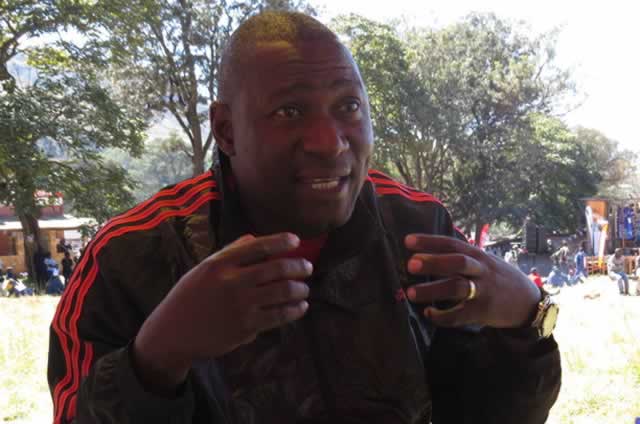‘Master Farmer’ comes to town

Sydney Kawadza
Studying rainfall patterns and its frequency used to be a special area for the rural folk.
As the simmering and blistering temperatures preceding the onset of the rains cause anxious moments for the rural people, the same anxiety is now shared by the “new” farmer who has emerged in urban areas.
As commercial and the peasant farmers wait in anticipation of the soothing rains, a promise of good harvest, abundant food, the urban farmers would be sweating over their small pieces of land that provide the much needed food security for their families.
The economic challenges that the country has faced in recent times, coupled with increasing knowledge of the effects of genetically modified foods and the cost of food have forced more people into urban agriculture.
As such, the number of urban farmers has shot up from a handful at the turn of the century to several hundred, forcing governments worldwide and their partners to acknowledge the phenomenon as important to food security.
Even the United Nations has acknowledged the importance of urban agriculture.
In a paper on Urban Agriculture for Sustainable Poverty Alleviation and Food Security, the Food and Agriculture Organisation acknowledges that urban agriculture is critical in promoting food security for the household.
“Food prices and household income are the two economic parameters, while distance, and costs of transport from and to markets, may represent physical constraints. Urban and peri-urban agriculture can favourably mitigate these constraints by making food and income available at household level.”
The UN agency describes urban and peri-urban agriculture as an industry located within (intra-urban) or on the fringe (peri-urban) of a town, a city or a metropolis, which grows and raises, processes and distributes a diversity of agriculture products, using largely human, land and water resources, products and services found in and around that urban area.
In the Zimbabwean context, while agriculture production has continued to grow in rural, A2, A1 and commercial farming areas, the cities have not been lagging behind.
Though agriculture in rural and commercial farming has tended to be large tracks of land, it is the urbanites who have also taken up the initiative to practise intensive agriculture on small available land.
Families have subdivided small pieces of land to grow maize for consumption as fresh mealies.
Some of these “plot holders” move across town for their small pieces of land. Farmers have invaded riverbanks, hilltops and storm drains and now road sides.
Some urban farmers have also assisted council get rid of large amounts of litter as they turn dumping sites into productive pieces of land.
Some have taken every opportunity to till the available space for maize production including areas clearly marked as private properties, areas where cultivation is prohibited including golf courses.
The lure of benefits of urban agriculture has left city fathers with headaches as almost every family seeks a plot to grow at least some mealies, pumpkins and vegetables.
The city authorities have to deal with increasing unplanned urban agricultural activities.
But farmers say they are out to supplement their earnings.
It is this thrust, according to Mrs Constance Zirangwa, who has a thriving one and half hectare crop of maize next to the Italian Sports Club in Mabelreign.
The 62-year-old grandmother who stays in Mufakose said she has had her plot since 2009 and has been feeding her family from that land.
“The plot has helps me feed my family. I have never bought any maize meal for all these years. Even in drier years I have managed to harvest enough to take me to the following year,” Mrs Zirangwa said.
She currently lives with seven relatives at her home. There are several challenges associated with urban agriculture.
“Just like the rural commercial farmer, we have challenges in accessing inputs such as fertilisers and seed. We have to hire tillage services
“There are times when we lose the crop to council employees who slash our maize. I understand this area is owned by some church organisation while others say it was bought by an individual who wants to develop the area,” she said.
Last season she harvested nearly two tonnes.
Danford Chinembiri of Kuwadzana says he is aware that some areas are prohibited for agriculture but adds that their activities are temporary.
“We plant our maize during the agricultural season and it is such areas that are lying ideal that we choose to grow the little to feed our families,” he said.
In Mufakose, Jossam Ali lamented the sprouting of housing co-operatives that are taking up all nearly all the open between the suburb and New Marimba.
“Slowly the open spaces are being eaten up by housing and soon we will be forced to look for agriculture land elsewhere,” he said.
Ms Patty Hove from Norton says despite using a small piece of land with her husband they have managed to produce enough for the family and even assist their neighbours.
“In these days of economic hardship, the little plots have become a reliable source of food for many families in the town,” she said.
The crop in most areas except the stony red soil in Dzivaresekwa promises to be a bumper harvest with maize in the vlei running from Greencroft to Rugare, some of the crops have reached tussling stages.
Gogo Tinos added: “These plains become waterlogged when the rainy season progress and there is need to add urea because of leaching but when you plant your crops with the early rains you are assured of a good harvest.”
Zimbabwe Institute of Regional and Urban Planners president Mr Percy Toriro said Harare was located on fertile soils good for farming and with good rainfall.
“The settlers saw the suitability of farming in the city from the beginning. Poor whites were allocated bigger plots in Waterfalls so that they could supplement their incomes by farming. You will still see people that grow crops and keep animals in Waterfalls today.
“In Mabvuku and Tafara, the city council allocated most residents with allotments for agriculture. So historically agriculture has always taken place in towns including in Zimbabwe.”
He, however, said urban and peri-urban agriculture is a delicate exercise that requires careful planning because of the intense competition for different land uses in urban areas.
“Cities are also complicated environments where anything must be deliberately and scientifically placed in space so that uses are compatible with their surroundings. For us as Town Planners, as we plan for industries, commerce, housing, recreation, and institutions, we must also remember other supporting uses” he said.
Mr Toriro said ZIRUP recommend that all urban areas have a clear policy and plan on urban farming.
“It is this plan that will set aside permissible areas and the rules that apply. This is the only way to create edible and sustainable cities that are food secure yet properly planned.”
Environment Management Agency spokesperson Mr Steady Kangata concurred saying urban and peri-urban agriculture must be practiced on suitable areas.
“This should be done at least 30 metres from the highest flood level of any river or stream. It does not matter whether agriculture is practiced in rural or urban areas, agricultural activities should not affect ecologically sensitive areas like wetlands,” he said.
Mr Kangata said unplanned agriculture activities can cause siltation leading to clogging storm drains causing flash floods when it rains.
“Chemical fertilizers can also be washed in water bodies becoming nutrients that promote the growth of weeds in our water bodies.
Harare City principal communications officer Mr Michael Chideme said council supports urban agriculture for its role in ensuring food sustenance and nutrition to the urban family.
“City by-laws support urban farming which is the reason we have agro zones in Harare such as the Hogerty Hills, Waterfalls, Tynwald, parts of Borrowdale, Marlborough and Hatfield.
“Stand sizes in these areas were set with urban farming in mind. You will find that in these areas residents keep livestock and have market gardens.”
He, however, added that not all open spaces were free for urban agriculture.
“Some of these open spaces are left open for recreational purposes, breathing spaces and others are private land for future developments. The city acknowledges the important role played by vegetation such as trees in the urban environment and therefore wants to keep the trees intact,” he said.
Mr Chideme said the city did not allow agricultural activities on road verges, steep slopes, along river banks and on wetlands.
“Residents should engage city authorities when they want to plant in open spaces to verify whether the space is free for urban farming. The city also urges urban farmers to practise good conservation methods that preserve our environment,” he said.
According to the Zimbabwe Agenda for Sustainable Socio-Economic Transformation (Zim-Asset)’s Food Security and Nutrition Cluster, the country aims to produce at 1.95 million tonnes of maize to ensure increased cereal availability.
Government’s thrust in the Food Security and Nutrition Cluster of Zim-Asset is to create a self-sufficient and food surplus economy that will see Zimbabwe emerge as the “bread basket of southern Africa”.
Feedback: [email protected] or [email protected]









Comments